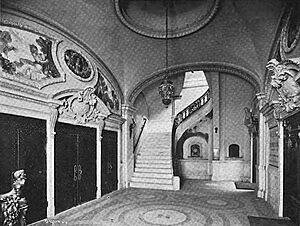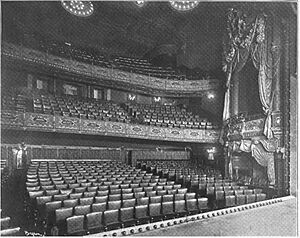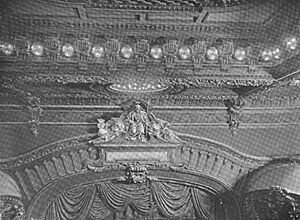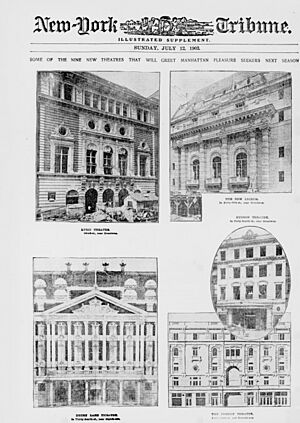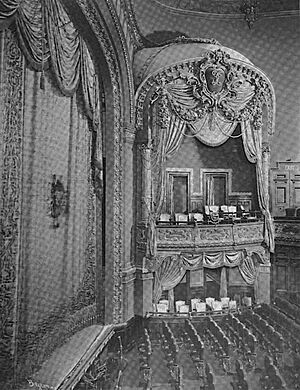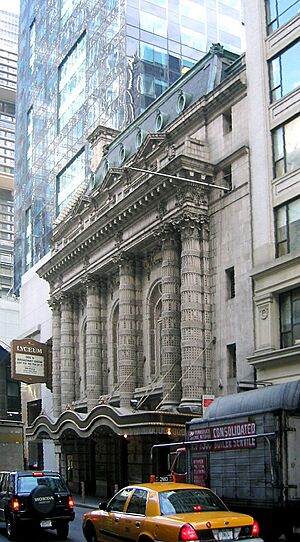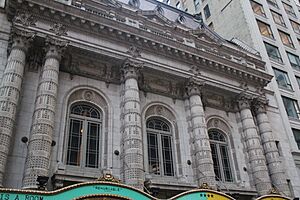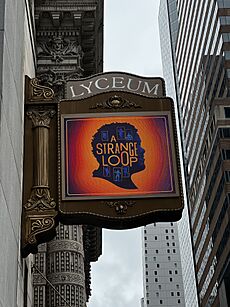Lyceum Theatre (Broadway) facts for kids
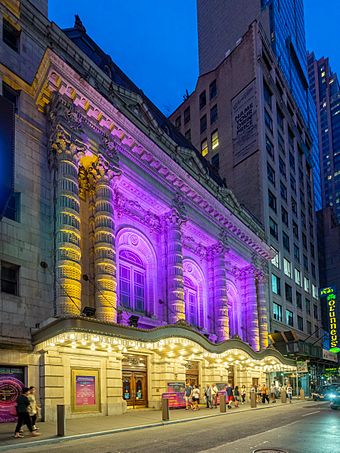
The theater showing Be More Chill (2019)
|
|
| Address | 149 West 45th Street Manhattan, New York City United States |
|---|---|
| Coordinates | 40°45′28″N 73°59′05″W / 40.75778°N 73.98472°W |
| Owner | The Shubert Organization |
| Capacity | 922 |
| Construction | |
| Opened | November 2, 1903 |
| Years active | 1903–present |
| Architect | Herts & Tallant |
| Website | |
| https://shubert.nyc/theatres/lyceum/ | |
| Designated | November 26, 1974 |
| Reference no. | 0803 |
| Designated entity | Facade |
| Designated | December 8, 1987 |
| Reference no. | 1352 |
| Designated entity | Lobby and auditorium interior |
The Lyceum Theatre (pronounced ly-SEE-əm) is a famous Broadway theater. You can find it at 149 West 45th Street in the Theater District of Midtown Manhattan, New York City. It first opened its doors in 1903.
The Lyceum Theatre is one of the oldest surviving Broadway theaters. It is also the oldest theater in New York City that has been open continuously. The theater was designed by Herts & Tallant in a beautiful style called Beaux-Arts. It was built for a theater owner named Daniel Frohman. The theater has 922 seats on three different levels. Today, it is run by The Shubert Organization. The outside of the theater became a special New York City landmark in 1974. The inside areas, like the lobby and main seating area, became landmarks in 1987.
The theater still looks much like it did when it first opened. Its design is from the Beaux-Arts period. The front of the building on 45th Street has a wavy glass and metal cover over the entrances. It also has a row of columns with three arched windows. Inside, the lobby has a special arched ceiling and paintings above the doors. Stairs lead up to the seating areas. The main seating area has fancy decorations around the stage and in the special box seats. However, the ceiling and walls are quite plain.
Above the lobby, there was an apartment where Daniel Frohman used to live. In 1986, this apartment became the home of the Shubert Archives. This is a place where old theater items are kept. The stage door, where actors enter, is on 46th Street. This part of the building also has dressing rooms and other backstage areas. The Lyceum Theatre replaced an older theater that Daniel Frohman owned. That one closed in 1902. The current Lyceum opened on November 2, 1903, with a play called The Proud Prince.
Frohman's brother, Charles Frohman, managed the theater until he passed away in 1915. Daniel Frohman then worked with David Belasco to put on shows until 1930. Later, Daniel Frohman lost the theater during the Great Depression. A group of famous theater people bought it in 1940. These included George S. Kaufman, Max Gordon, and Moss Hart. The Shubert Organization has been running the theater since 1950.
Contents
Where the Theater Is
The Lyceum Theatre is located at 149 West 45th Street. It sits between Seventh Avenue and Sixth Avenue. This area is very close to Times Square in the Theater District of Midtown Manhattan, New York City.
The theater building covers a large area. It has a front section on 45th Street. There is also a part that extends north to 46th Street. This back part is where the stage door and other facilities are. The land where the theater stands used to have houses on it.
Many other famous buildings are nearby. These include the Museum of Broadway right next door. Also close by are the Palace Theatre and the Hudson Theatre.
Theater Design
The Lyceum Theatre was designed by Herts & Tallant. It was built between 1902 and 1903. The theater was made for the famous theater owner Daniel Frohman. It is the oldest theater in New York City that has been open all the time.
Outside the Theater
45th Street Side
The main front of the theater is on 45th Street. It is made of light-colored stone called limestone. When the theater opened in 1903, people said its design reminded them of old Roman art.
At street level, the front has rough-looking stone blocks. Three big archways lead into the lobby. The doors are made of painted wood with arched glass panels. A curvy metal and glass cover, called a marquee, protects these entrances. This marquee was replaced in 1986 with a new one that looks just like the original. It has fancy metal designs and glass panels.
Above the entrance, the 45th Street side has a row of three sections. These sections are separated by pairs of fancy columns. Each section has a French window with an arched frame. Above the windows, there is a decorative band with six stone faces. These faces represent comedy and tragedy.
The theater has a special roof called a mansard roof. This roof has three windows that let light into a small apartment area. There is also a balcony at this level. The roof also had six oval windows that lit up a rehearsal room. In the past, the roof had four large urns that would light up with gas at night. This helped people notice the theater, as it was on a side street.
46th Street Side
The stage door is on 152 West 46th Street. This part of the building is a tall, 10-story section. It was also designed by Herts & Tallant. This section has a simple design. It used to have a slot for moving backdrops between the stage and the upper floors.
Inside the Theater
Daniel Frohman had his offices and apartment on the upper floors of the main building. The back part on 46th Street held things like storage and dressing rooms. The inside of the theater was designed with colors like deep yellow, warm red, and brown.
The theater was built to use only electric lights. The stage lights could be controlled to be as bright as natural sunlight. The building was also very modern for its time. It had heating, cooling, and ventilation systems. It also had a fireproof structure. The air system could change all the air in the main seating area every six minutes.
Lobby
The entrance lobby is a long, rectangular room. It has arched openings on the north and south walls. The floor is made of marble tiles. In the middle of the floor, there is a special design with the letter "L" for Lyceum. The walls have marble at the bottom and columns with leafy designs.
The ceiling of the lobby has a special arched shape. It has decorative borders and flower-like designs. In the center of the ceiling, there is a dome with a chandelier.
The doors on the south side lead to the street. The doors on the north side lead into the main seating area. Above these doors, there are paintings by James Wall Finn. These paintings show female figures and portraits of famous actors.
On the west and east sides, there are curved stairs made of marble and steel. These stairs lead up to the first balcony. The stairs have bronze railings with fancy decorations. There are also ticket windows on the east wall.
Main Seating Area
The main seating area, called the auditorium, has seats on the ground level (orchestra), special box seats, and two balconies. The stage is at the front, behind a large archway. The auditorium is wider than it is deep. It has many plaster decorations. Most of the fancy designs are around the stage and the box seats. The walls themselves are quite plain. This design helps draw everyone's eyes to the stage.
The auditorium has 922 seats. This makes the Lyceum one of the smaller Broadway theaters. There are 409 seats on the ground level, 287 on the first balcony, and 210 on the second balcony. There are also 16 seats in the special boxes. The seats were originally covered in dark yellow leather. Each seat was wider than usual, making them more comfortable.
Seating Areas
At the back of the ground-level seating area, there is a walkway. It has wood-paneled walls and "L" designs. The ground-level floor slopes down towards the stage. The side walls have decorated panels. The ground level is accessible for wheelchairs. However, the balcony levels can only be reached by stairs.
The balconies are special because they stick out from the building's frame. This means there are no columns blocking the view for the audience. The balconies have wood panels on their sides and backs. They also have lights underneath them.
On each side of the stage, there is a section with one box seat on the first balcony level. These sections have columns that support an arch. The boxes themselves have curved railings with leaf designs.
Other Design Features
The arch around the stage is called the proscenium arch. It is about 33 feet high and 31 feet wide. This arch has a wide, decorated band with leafy designs. Above the center of the arch, there is a special bracket with hanging decorations. It also has a broken arch shape with a figure of Pallas Athene. This figure is flanked by female figures representing drama and music.
The stage itself is about 37 feet deep and 89 feet wide. It used to have a lift that could go down 30 feet below the stage. This lift could move scenery or create different ground levels, like cliffs or rivers.
The ceiling of the auditorium is curved. It has decorative brackets and designs of fruits and flowers. In the center of the ceiling, there is a rectangular panel with more decorations. There are also circular "L" designs. The ceiling does not have a large chandelier. Instead, lights are hidden in the ceiling. The designers thought a chandelier would distract from the show.
Other Rooms
Daniel Frohman's apartment and office were on the south side of the theater. This area faced 45th Street. It became his main home. He could even watch performances from a small window in his dining room. This window was above the second balcony. His office was filled with paintings, drawings, and photos of theater stars. It even had a phone line to the stage manager.
Frohman's offices were later turned into the Shubert Archive. This archive holds a huge collection of theater items from The Shubert Organization. It was started in 1976 and opened at the Lyceum in 1986. It has millions of items, including costume designs, blueprints, and scripts.
The 46th Street part of the building had other important rooms. These included a studio for painting scenery and a carpentry shop. It also had a costume department and storage areas. The scene-painting studio was very tall and had a glass wall for natural light. The dressing rooms were large and could fit many actors. These old scenery rooms are now also part of the Shubert Archive. They hold things like music scores and old financial records.
Theater History
Around 1900, the Times Square area became the main place for big theater shows. Before this, theaters were more spread out. The Lyceum, along with the Hudson and New Amsterdam theaters, were among the first to open in this new theater district in 1903. The Lyceum is one of the oldest Broadway theaters still standing.
How the Theater Was Built
Daniel Frohman used to run an older Lyceum Theatre on Fourth Avenue. But that theater was bought by a company to build a new tower. So, in 1902, Frohman announced he bought land on 45th and 46th Streets. He planned to build a new 900-seat theater there. The main seating area would be on 45th Street. A narrower part with dressing rooms would be on 46th Street.
Frohman hired Herts & Tallant to design the new theater. Construction began on April 1, 1902. The first stone was laid on October 16, 1902. Thirteen bricks from the old Lyceum were placed into the new theater. The theater was supposed to open in September 1903. However, there were delays. The new Lyceum Theatre officially opened on November 2, 1903. The first show was The Proud Prince.
Frohman's Time
Early Years
When the Lyceum Theatre first opened, an architecture magazine praised its design. It was seen as a theater for "high-class dramatic performance." Some people thought the theater was too far uptown to be successful. But it soon became popular. Charles Frohman, Daniel's brother, was the first manager. The theater was meant for "drawing-room comedies," which are plays about polite society.
Many successful plays were shown at the Lyceum. These included The Admirable Crichton in 1903. The Lion and the Mouse opened in 1905 and ran for 686 performances. Daniel Frohman's wife, Margaret Illington, also performed there. Famous actresses like Ethel Barrymore, Billie Burke, and Ina Claire also graced the Lyceum stage. In 1912, the theater even hosted the U.S. premiere of a French silent film.
Working with Belasco
Charles Frohman died in 1915 when the RMS Lusitania sank. In 1916, David Belasco became a manager of the Lyceum Theatre. He had worked with Charles Frohman often. Major shows in the late 1910s included Tiger Rose (1917) and The Gold Diggers (1919). The Gold Diggers ran for 720 performances. Daniel Frohman also managed the Actors' Fund from his office in the theater.
The Lyceum hosted many romantic comedies in the 1920s. The theater was restored in 1922. It also showed revivals of classic plays like The Merchant of Venice (1922) and Antony and Cleopatra (1924). In the late 1920s, shows like Fanny (1926) and Berkeley Square (1929) were popular. Daniel Frohman and David Belasco's partnership ended when Belasco died in 1931.
The Great Depression and New Owners
The Lyceum Theatre faced tough times during the Great Depression. Most shows did not run for very long. Some longer-running plays included Sailor, Beware! (1933), which ran for 500 performances. In 1935, the bank that held the theater's mortgage tried to take it over. Daniel Frohman was allowed to stay in his apartment in the theater.
Long-running shows in the late 1930s included Having Wonderful Time (1937) with John Garfield. By 1939, the bank was trying to sell the Lyceum. It was in danger of being torn down. But a friend of Frohman's helped. The bank promised Frohman could live in his apartment for the rest of his life. The bank bought the theater in December 1939.
In May 1940, a group of theater professionals bought the Lyceum. This group included playwright George S. Kaufman, producer Max Gordon, and playwright Moss Hart. They paid $250,000 for it. Daniel Frohman was allowed to live in his apartment for $1 a year. He passed away in December 1940.
Some of the first shows under the new owners were George Washington Slept Here (1940) and Junior Miss (1941). Then came The Doughgirls, which ran for 671 performances. The Lyceum then hosted Born Yesterday. This play opened in 1946 and became the theater's longest-running show ever, with 1,642 performances!
In 1949, the theater was sold to Harry Gould. The first big show in the 1950s was The Country Girl in 1950.
Shubert Takes Over
1950s to 1970s
In 1952, The Shubert Organization took over the Lyceum. In 1954, the theater hosted King of Hearts and Anastasia. Both ran for over 200 performances. Other popular shows included A Hatful of Rain (1955) and Look Back in Anger (1957).
From 1965 to 1969, the Association of Producing Artists (APA) and Phoenix Theatre used the Lyceum. They put on classic plays like You Can't Take It With You and Hamlet.
The 1970s were a difficult time for Broadway. Few shows at the Lyceum had long runs. In 1974, the outside of the theater was named a city landmark. This meant that any changes to the outside had to be approved. The Shuberts, who owned the theater, were not happy about this at first. A special plaque was put on the building in 1978.
1980s and 1990s
In the 1980s, the Lyceum hosted shows like "Master Harold"...and the Boys (1982) and a show by comedian Whoopi Goldberg in 1984. In 1986, the old marquee on the front of the building was replaced. The Shubert Archive also opened in 1986.
In 1987, the inside of the Lyceum was also named a city landmark. This was part of a big effort to protect many Broadway theaters. The theater owners tried to fight these landmark rules in court. But the rules were upheld in 1992.
The National Actors Theatre, led by Tony Randall, moved to the Lyceum in 1992. They used the theater for most of the 1990s. They put on plays like The Seagull and Saint Joan. They also performed Timon of Athens and The Gin Game.
The Shubert Organization also leased out unused "air rights" above the theater. This allowed a nearby skyscraper to be built taller. This agreement meant the Lyceum had to stay a legitimate theater.
2000s to Today
After the National Actors Theatre left, the Lyceum hosted Rose in 2000. Other shows included The Invention of Love (2001) and I Am My Own Wife (2003). In 2003, the Shuberts agreed to make their theaters, including the Lyceum, more accessible for people with disabilities. The roof and front of the theater were repaired in 2005.
In the late 2000s, the Lyceum hosted plays and musicals like Inherit the Wind and Reasons to Be Pretty.
The Lyceum Theatre continued to host many shows in the 2010s. These included Venus in Fur (2012), The Nance (2013), and A View from the Bridge (2015). Later, The Play That Goes Wrong (2017) and Be More Chill (2019) were popular.
The theater closed on March 12, 2020, because of the COVID-19 pandemic. It reopened on October 11, 2021, with two plays, Is This A Room and Dana H.. In April 2022, A Strange Loop opened and ran until January 2023. This was followed by Grey House in May 2023.
A play called Oh, Mary! is expected to transfer to the Lyceum in July 2024.
Famous Shows
Here are some notable plays and musicals that have been performed at the Lyceum Theatre. They are listed by the year they first opened.
1900s to 1990s
- 1903: The Admirable Crichton
- 1904: David Garrick
- 1905: A Doll's House
- 1907: The Truth
- 1909: Arsène Lupin
- 1909: Penelope
- 1910: The Pillars of Society
- 1910: The Assumption of Hannele
- 1910: The Importance of Being Earnest
- 1913: The Ghost Breaker
- 1915: John Gabriel Borkman
- 1917: The Great Divide
- 1917: The Case of Lady Camber
- 1919: The Gold Diggers
- 1922: The Merchant of Venice
- 1923: The School for Scandal
- 1924: Antony and Cleopatra
- 1924: Ladies of the Evening
- 1926: The Sport of Kings
- 1929: Berkeley Square
- 1931: Anatol
- 1935: Squaring the Circle
- 1936: St. Helena
- 1939: The Mother
- 1939: When We Are Married
- 1941: Junior Miss
- 1942: The Doughgirls
- 1946: Born Yesterday
- 1950: The Enchanted
- 1950: The Country Girl
- 1952: Anna Christie
- 1952: Time Out For Ginger
- 1955: A Hatful of Rain
- 1957: Look Back in Anger
- 1958: The Gazebo
- 1959: The Billy Barnes Revue
- 1959: Flowering Cherry
- 1959: Goodbye Charlie
- 1960: A Taste of Honey
- 1960: The Importance of Being Oscar
- 1960: Mandingo
- 1961: The Caretaker
- 1963: Ages of Man
- 1963: Nobody Loves an Albatross
- 1965: Entertaining Mr. Sloane
- 1965, 1967: You Can't Take It With You
- 1966: The School for Scandal
- 1967: The Wild Duck
- 1967: By George
- 1967, 1968: The Show-off
- 1968: Exit the King
- 1968: The Cherry Orchard
- 1968: The Cocktail Party
- 1968: The Misanthrope
- 1969: Cock-a-Doodle Dandy
- 1969: Hamlet
- 1969: Three Men on a Horse
- 1970: Norman, Is That You?
- 1970: Borstal Boy
- 1971: The School for Wives
- 1972: The Great God Brown and Don Juan
- 1973: Out Cry
- 1975: The Lieutenant
- 1976: Something's Afoot
- 1976: Best Friend
- 1976: Your Arms Too Short to Box with God
- 1979: Wings
- 1980: Morning's at Seven
- 1982: "Master Harold"...and the Boys
- 1983: The Man Who Had Three Arms
- 1985: As Is
- 1988: Our Town
- 1993: Saint Joan
- 1993: Three Men on a Horse
- 1993: Timon of Athens
- 1994: The Government Inspector
- 1994: The Flowering Peach
- 1995: Gentlemen Prefer Blondes
- 1995: The School for Scandal
- 1997: The Gin Game
- 1997: The Sunshine Boys
- 1999: Night Must Fall
- 1999: The Lonesome West
2000s to Present
- 2001: The Invention of Love
- 2002: Morning's at Seven
- 2003: The Play What I Wrote
- 2003: I Am My Own Wife
- 2005: Steel Magnolias
- 2006: The Lieutenant of Inishmore
- 2007: Inherit the Wind
- 2007: Is He Dead?
- 2008: Macbeth
- 2008: [title of show]
- 2009: Reasons to Be Pretty
- 2010: Looped
- 2010: The Scottsboro Boys
- 2012: Venus in Fur
- 2013: The Nance
- 2014: The Realistic Joneses
- 2014: Disgraced
- 2015: The Visit
- 2015: A View from the Bridge
- 2016: Fully Committed
- 2016: Oh, Hello
- 2017: The Play That Goes Wrong
- 2019: Be More Chill
- 2019: A Christmas Carol
- 2021: Is This a Room and Dana H.
- 2022: A Strange Loop
- 2023: Grey House
Box Office Records
The Lyceum Theatre has set some impressive box office records. In 2008, Macbeth earned $584,033 in one week. This was a record for seven performances.
In 2019, Be More Chill broke that record. It earned $738,384 in one week. Oh, Hello set a record for eight performances in 2017. It grossed $804,513.
The musical A Strange Loop broke the eight-performance record in January 2023. It earned $955,590 in its final week.
See Also
- List of Broadway theaters
- List of New York City Designated Landmarks in Manhattan from 14th to 59th Streets



